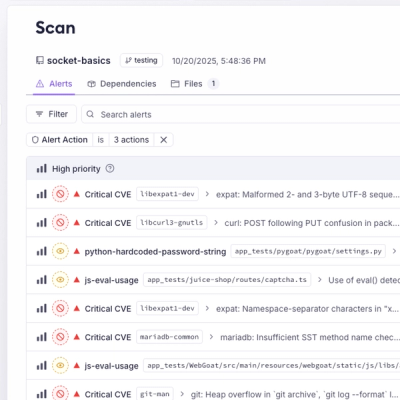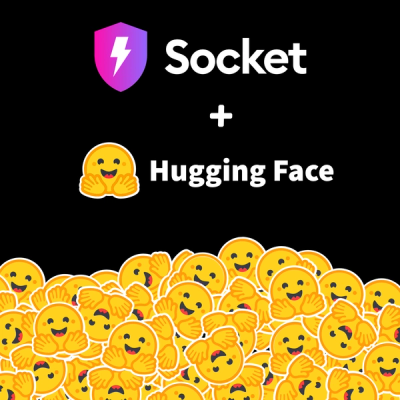
Product
Unify Your Security Stack with Socket Basics
A single platform for static analysis, secrets detection, container scanning, and CVE checks—built on trusted open source tools, ready to run out of the box.
@dark-engine/platform-browser
Advanced tools
Dark renderer for browser.
from template:
npx degit github:atellmer/dark/templates/browser app
cd app
npm i
npm start
npm:
npm install @dark-engine/core @dark-engine/platform-browser
yarn:
yarn add @dark-engine/core @dark-engine/platform-browser
CDN:
<script src="https://unpkg.com/@dark-engine/platform-browser/dist/umd/dark-platform-browser.production.min.js"></script>
import {
type DarkJSX,
type SyntheticEvent,
type CSSProperties,
createRoot,
hydrateRoot,
createPortal,
factory,
VERSION,
} from '@dark-engine/platform-browser';
To create an application entry point, you need to use the special createRoot method.
import { createRoot } from '@dark-engine/platform-browser';
const root = createRoot(document.getElementById('root'));
root.render(<App />);
The platform supports rendering multiple independent applications to different DOM elements. This can be useful for creating custom widgets that don't affect how the main application works.
const root1 = createRoot(document.getElementById('root-1'));
const root2 = createRoot(document.getElementById('root-2'));
root1.render(<AppOne />);
root2.render(<AppTwo />);
setInterval(() => {
count++;
root.render(<App count={count} />);
}, 1000);
Clears all subscriptions, variables and content without a trace.
root.unmount();
Dark employs the standard DOM event system, with event names written in camelCase. Event handlers are functions passed to event attributes, which receive a synthetic event encapsulating a native event.
Synthetic events are utilized to emulate the behavior of stopPropagation. This emulation is necessary due to Dark's performance-optimized approach of delegating native events to the document element, rather than the originating element.
For instance, when subscribing to a button click event, the event is monitored across the entire document, not on the button. This is a key aspect of Dark's event handling mechanism.
import { type SyntheticEvent } from '@dark-engine/platform-browser';
const handleInput = (e: SyntheticEvent<InputEvent, HTMLInputElement>) => setValue(e.target.value);
const handleClick = (e: SyntheticEvent<MouseEvent, HTMLButtonElement>) => console.log('click');
<input value={value} onInput={handleInput} />
<button onClick={handleClick}>Click me</button>
This refers to a browser-specific feature that allows the redirection of the rendering flow to another element in the DOM tree. It's primarily used for modal windows, dropdown menus, and any situation where it's crucial to prevent overlap by the parent container due to configured CSS overflow.
import { createPortal } from '@dark-engine/platform-browser';
const App = component(() => {
const host = useMemo(() => document.createElement('div'), []);
useLayoutEffect(() => {
document.body.appendChild(host);
return () => document.body.removeChild(host);
}, []);
return (
<>
<div>Hello world</div>
{createPortal(<div>I will be placed in a new container</div>, host)}
</>
);
});
The function that creates elements based on their name if you don't use JSX.
import { factory } from '@dark-engine/platform-browser';
const div = factory('div'); // <div></div>
const customElement = factory('custom-element'); // <custom-element></custom-element>
For convenience, the package exports all html and svg tags:
import { Text } from '@dark-engine/core';
import { div, button, input, svg, ... } from '@dark-engine/platform-browser';
You can use it like this:
div({
slot: [
button({
class: 'awesome-button',
onClick: () => console.log('click'),
slot: Text('Click me'),
})
]
})
it's the same as writing
<div>
<button
class="awesome-button"
onClick={() => console.log('click')}>
Click me
</button>
</div>
Hydration is the process of reinstating the interactivity of an application once the content, delivered as a string and a JavaScript bundle, has been received by the user's browser. This process is achieved by reusing pre-existing DOM nodes, initializing the library's internal mechanisms, and attaching event handlers.
import { hydrateRoot } from '@dark-engine/platform-browser';
import { App } from './app';
hydrateRoot(document.getElementById('root'), <App />);
MIT © Alex Plex
FAQs
Dark renderer for browser
The npm package @dark-engine/platform-browser receives a total of 208 weekly downloads. As such, @dark-engine/platform-browser popularity was classified as not popular.
We found that @dark-engine/platform-browser demonstrated a healthy version release cadence and project activity because the last version was released less than a year ago. It has 1 open source maintainer collaborating on the project.
Did you know?

Socket for GitHub automatically highlights issues in each pull request and monitors the health of all your open source dependencies. Discover the contents of your packages and block harmful activity before you install or update your dependencies.

Product
A single platform for static analysis, secrets detection, container scanning, and CVE checks—built on trusted open source tools, ready to run out of the box.

Product
Socket is launching experimental protection for the Hugging Face ecosystem, scanning for malware and malicious payload injections inside model files to prevent silent AI supply chain attacks.

Research
/Security News
The Socket Threat Research Team uncovered a coordinated campaign that floods the Chrome Web Store with 131 rebranded clones of a WhatsApp Web automation extension to spam Brazilian users.